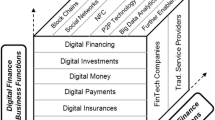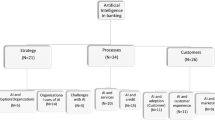Abstract
This paper investigates the provision of financial services by banks as a two-stage production process involving three different basic activities. The first stage includes service activities, while the second stage comprises both investment-related and risk management activities. Financial services performance is assessed in terms of service efficiency and investment and risk management efficiency for years 2002–2010. The major empirical findings are that the Internet-primary bank is more efficient than most branching banks in deposit-raising activities, but with regard to investment and risk management activities, there are many brick-and-mortar banks that match the online bank performance.

Similar content being viewed by others
References
Aizpurua LI, Saldaña PEZ, Saldaña AZ (2011) Learning for sharing: an empirical analysis of organizational learning and knowledge sharing. Int Entrepren Manag J 7(4):509–518
Banker RD, Charnes A, Cooper WW (1984) Some models for estimating technical and scale inefficiencies in data envelopment analysis. Manage Sci 30:1078–1092
Berger AN (2007) International comparisons of banking efficiency. Finan Markets Inst Instrum 16:119–144
Berger AN, Humphrey DB (1997) Efficiency of financial institutions: international survey and directions for future research. Eur J Oper Res 98:175–212
Bettiol M, Di Maria E, Finotto V (2012) Marketing in SMEs: the role of entrepreneurial sense making. Int Entrepren Manag J 8(2):223–248
Caceres R, Guzman J, Rekowsky M (2011) Firms as source of variety in innovation: influence of size and sector. Int Entrepren Manag J 7(3):357–372
Casu B, Girardone C (2004) Financial conglomeration: efficiency, productivity and strategic drive. Appl Finan Econ 14:687–696
Casu B, Girardone C (2006) Bank competition, concentration and efficiency in the single European Market. The Manchester School 74:441–468
Casu B, Molyneux P (2003) A comparative study of efficiency in European banking. Appl Econ 35:1865–1876
Cegarra-Navarro JG, Sanchez-Vidal ME, Cegarra-Leiva D (2011) Balancing exploration and exploitation of knowledge through an unlearning context: an empirical investigation in SMEs. Manag Decis 49(7):1099–1119
Charnes A, Neralic L (1990) Sensitivity analysis of the additive model in Data Envelopment Analysis. Eur J Oper Res 48:332–341
Charnes A, Cooper WW, Rhodes E (1978) Evaluating program and managerial efficiency: an application of data envelopment analysis to program follow through. Manage Sci 27:668–697
Charnes A, Charnes J, Rousseau J (1996) Sensitivity and stability of efficiency classifications in Data Envelopment Analysis. J Prod Anal 7:5–18
Chen T-Y (2001) An estimation of X-inefficiency in Taiwan’s banks. Appl Finan Econ 11:237–242
Cho I, Park H, Choi J (2011) The impact of diversity of innovation channels on innovation performance in service firms. Serv Bus 5(3):277–294
Crevani L, Palm K, Shilling A (2011) Innovation management in service firms: a research agenda. Serv Bus 5(2):177–193
Das A, Ghosh S (2006) Financial deregulation and efficiency: an empirical analysis of Indian banks during the post reform period. Rev Finan Econ 15:193–221
De Cleyn SH, Braet J (2012) Do board composition and investor type influence innovativeness in SMEs? Int Entrepren Manag J 8(3):285–308
De Young R (2001) The financial performance of pure play Internet banks. Econ Perspect 25(1), first quarter, Bank of Chicago
De Young R (2005) The performance of Internet-based business models: evidence from the banking industry. J Bus 78(3):893–947
Fare R, Grosskopf S, Weber WL (2004) The effect of risk-based capital requirements on profit efficiency in banking. Appl Econ 36:1731–1743
Farrell MJ (1957) The measurement of productive efficiency. J R Stat Soc A 120:253–281
Ferreira JJ, Marques CS, Azevedo C (2011) Competitiveness, resources, and capabilities: empirical evidence from retail banking. Serv Bus 5(4):313–337
Fethi MD, Pasiouras F (2010) Assessing bank efficiency and performance with operational research and artificial intelligence techniques: a survey. Eur J Oper Res 204:189–198
Group ING (2008) Focus blijftgericht op risico. ING Shareholder 4:14
Han-Min Wang D, Hui-Kuang YuT, Ye F-R (2012) The value relevance of brand equity in the financial services industry: an empirical analysis using quantile regression. Serv Bus 6(4):459–471
Holod D, Lewis HF (2011) Resolving the deposit dilemma: a new DEA bank efficiency model. J Bank Finance 35:2801–2810
Isik I, Hassan MK (2002) Technical, scale and allocative efficiencies of Turkish banking industry. J Bank Finance 26:719–766
Lee SM, Lim SB, Pathak RD (2011) Culture and entrepreneurial orientation: a multi-country study. Int Entrepren Manag J 8(3):285–308
Lee SM, Hwang T, Choi D (2012a) Open innovation in the public sector of leading countries. Manag Decis 50(1):147–162
Lee SM, Olson DO, Trimi S (2012b) Co-innovation: convergenomics, collaboration, and co-creation for organizational values. Manag Decis 50(5):817–831
Lindic J, Marques da Silva C (2011) Value proposition as a catalyst for a customer focused innovation. Manag Decis 49(10):1694–1708
Lozano-Vivas A, Pastor JT, Pastor JM (2002) An efficiency comparison of European banking systems operating under different environmental conditions. J Prod Anal 18:59–77
Momparler A, Climent FJ, Ballester JM (2012) The impact of scale effects on the prevailing Internet-based banking model in the US. Serv Bus 6(2):177–195
Naranjo-Valencia JC, Jimenez–Jimenez D, Sanz-Valle R (2011) Innovation or imitation? The role of organizational culture. Manag Decis 49(1):55–72
Pasiouras F (2008a) International evidence on the impact of regulations and supervision on banks’ technical efficiency: an application of two-stage data envelopment analysis. Rev Quant Financ Acc 30:187–223
Pasiouras F (2008b) Estimating the technical and scale efficiency of Greek commercial banks: the impact of credit risk, off-balance sheet activities, and international operations. Res Int Bus Finan 22:301–318
Sealey C, Lindley J (1977) Inputs, outputs, and a theory of production and cost at depository financial institutions. J Finan 32:1251–1266
Server-Izquierdo RJ, Capo-Vicedo J (2012) Corporate social responsibility of financial organizations in the social economy: a case study on savings banks. Serv Bus 6(1):99–115
Sturm J-E, Williams B (2004) Foreign bank entry, deregulation and bank efficiency: lessons from the Australian experience. J Bank Finance 28:1775–1799
Tsionas EG, Lolos SEG, Christopoulos DK (2003) The performance of the Greek banking system in view of the EMU: results from a non-parametric approach. Econ Model 20:571–592
Van Riel ACR, Semeijn J, Hammedi W, Henseler J (2011) Technology-based service proposal screening and decision-making effectiveness. Manag Decis 49(5):762–783
Yang TT, Li CR (2011) Competence exploration and exploitation in new product development: the moderating effects of environmental dynamism and competitiveness. Manag Decis 49(9):1444–1470
Zortea-Johnston E, Darroch J, Matear S (2012) Business orientations and innovation in small and medium sized enterprises. Int Entrepren Manag J 8(2):145–165
Acknowledgments
Financial support from the Ministry of Science and Technology of Spain (research project ECO2009-14457-C04-04) is gratefully acknowledged.
The authors gratefully acknowledge the contributions of Ramon Sala and Francisco J. Climent to this research.
Author information
Authors and Affiliations
Corresponding author
Rights and permissions
About this article
Cite this article
Momparler, A., Lassala, C. & Ribeiro, D. Efficiency in banking services: a comparative analysis of Internet-primary and branching banks in the US. Serv Bus 7, 641–663 (2013). https://doi.org/10.1007/s11628-012-0179-1
Received:
Accepted:
Published:
Issue Date:
DOI: https://doi.org/10.1007/s11628-012-0179-1




